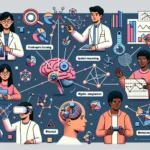Unlocking the Mysteries of Spatial Intelligence: A Dive into the Study of Its Measurement
Have you ever wondered how people are able to mentally visualize objects, maneuver through unfamiliar cities, or solve complex puzzles with apparent ease? These actions are all linked to a powerful cognitive ability known as spatial intelligence. However, to harness it more effectively and understand its implications, researchers have delved into studying its components and how it can be measured. The groundbreaking study titled “Analysis of Spatial Intelligence and Its Measurement” shines a light on this often-overlooked aspect of our intellect.
The Importance of Spatial Intelligence
Spatial intelligence is a critical component of our cognitive toolkit, enabling us to process and understand the spatial relationships between objects. It’s instrumental in a wide range of everyday tasks and occupations, from engineering and architecture to the visual arts and beyond. But its significance goes further—it plays a role in our capacity for navigating environments, understanding maps, and even engaging with the latest virtual reality technologies.
Peering into the Study
The study in question breaks new ground by meticulously analyzing the way spatial intelligence operates and can be quantified. Through a series of carefully designed tests, it explores the different dimensions of this type of intelligence, such as spatial visualization, mental folding, and spatial orientation. The researchers’ objectives were to categorize these various components, define them more clearly, and identify reliable methods of assessment.
Delving into the research, the paper highlights the various techniques and tools used to measure spatial intelligence, from traditional pen-and-paper tests to cutting-edge computer-based assessments. This comparative approach is critical in identifying the strengths and limitations of each method, thereby offering a comprehensive understanding of how spatial intelligence can be most accurately gauged.
The study emphasizes the importance of standardized testing environments to ensure that the measurement of spatial intelligence is consistent and unbiased. By controlling for extraneous factors that might impact test performance, such as prior knowledge or environmental distractions, the study paves the way for more precise evaluation tools.
Implications and Applications
The implications of this research are vast. In education, for instance, understanding spatial intelligence at a deeper level could inform teaching methods to cater better to students with high spatial reasoning skills. Tailored educational programs could nurture this kind of intelligence, potentially leading to advancements in fields that heavily rely on spatial reasoning.
Furthermore, in the realm of employment, employers could leverage insights from the study to identify individuals with advanced spatial capabilities, streamlining the recruitment process for roles that require such skills. It also opens doors for developing training programs to enhance spatial intelligence among employees, boosting performance and efficiency in spatially-demanding jobs.
The Future of Spatial Intelligence Measurement
Looking ahead, the conclusions drawn from the “Analysis of Spatial Intelligence and Its Measurement” study set the stage for more advanced research in this field. As technology evolves, new forms of assessment may emerge, employing virtual reality, artificial intelligence, and other innovative tools to expand our capabilities in evaluating and understanding spatial intelligence.
In conclusion, the study “Analysis of Spatial Intelligence and Its Measurement” offers critical insights into a dimension of human intelligence that shapes how we interact with the world around us. Its findings have the potential to influence educational strategies, workplace dynamics, and the development of new technologies, all while enhancing our comprehension of the human mind’s spatial faculties. As we continue to explore and assess the depths of spatial intelligence, we are sure to find new ways to maximize human potential, both individually and collectively.

